The crustaceans belong to the most successful group of animals on the planet – the arthropods. The phylum Arthropoda has an estimated 800,000 species, some say almost one million, which equates to about 90% of all animals on the planet. Most of those are insects. They can be found in almost any habitat on Earth. From the deepest portions of the ocean to the peaks of the highest mountains and in between. They have even taken to the air. Insects are the only true flying invertebrates.
Arthropods can easily be recognized. They have a segmented body. Many have three segments – the head, the thorax, and the abdomen. Some have fused the head and the thorax into one segment – the cephalothorax. Extending from the thorax region are jointed legs (where they get their name from… “arthropod” means “jointed-foot”). These jointed legs have hinge joints and much like an erector set, or Legos. The more joints, the more movement, but all are specialized enough to be to manipulate their environment.

Image: Study Blue
Their bodies are covered by an exoskeleton. This can serve as a protective shell but made of a thinner/lighter material than the mollusks calcium carbonate. Instead their exoskeleton is made of chitin. This light material makes it much easier for arthropods to move and thus they can have speed and protection at the same time. However, this chitinous exoskeleton does not grow as fast as the arthropod itself and must be periodically shed in a process called ecdysis, or molting. This process can be very stressful for the arthropod. Removing the exterior shell means removing your protection AND the covering of important body parts such as the claws of a blue crab. The animal is completely soft after shedding and vulnerable. They typically do this under cover and at night. One of the predators during this time are themselves. This is one reason they place rubber bands on lobster claws at the supermarket. To keep them from eating any other who may have molted overnight.
This process begins with hormones telling the arthropod it is time. They will find a secure location and begin to remove salts and minerals from the chitinous shell into their tissue. This makes the shell thinner and easier to break. Under the cover of darkness, they will begin to push on a pressure point on their shell, crack it, and the soft animal will emerge sometimes 30% larger and very colorful, but soft. Now, they must excrete salts and minerals back into the new shell to harden it. The whole process can take a couple of days. The famous “soft shell crabs” are those that have molted but have not harden their shells yet. They are a popular seafood item. There are hormones within the eye stalk of some crustaceans that can be secreted voluntarily by the animal to stop molting if they feel the situation is too dangerous. Removing the eye stalk can stop this process and force the crab to molt anyway. Something that is done within the industry to produce soft shell crabs when needed. Many shrimp will molt when they sense danger. Possibly to create two shrimp – one real, one a molt, to confuse predators. Often shrimp captured in a shrimp trawl have molted. Molting is something that all arthropods must do.
Another characteristic mentioned is their jointed legs. For decades school kids have learned the different groups of arthropods by how many jointed legs they have. Insects have six, arachnids have eight, and crustaceans have ten. Millipedes are long segmented arthropods that resemble worms and appear to have “a million legs”. But in fact, they have two pairs (four total) per segment. Centipedes have only one pair (two total) per segment. Some arthropods have modified their legs into chelipeds (claws). Others (insects) into wings so they can fly. Some insects only have wings for part of their lives.
Another method of identification of the subgroups are the presence of antenna. Insects have one pair (two total), crustaceans have two pairs (four total, two long and two short), and arachnids do not have antenna at all.
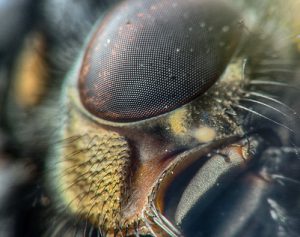
Photo: Flickr
These are bilateral/coelomates. So, they have a distinct head region and an internal cavity for the development of organs. The head is well developed in many arthropods and the brain can be well developed with numerous sensory organs and complex behaviors. Arthropods are famous for their compound eyes. This means they have more than one lens. Humans have a single lens giving us a clear image of our friend across the table. Arthropods can have anywhere from 25 to 100 lenses (ommatids). Despite what is shown in the movies, they do not see 25 to 100 images of your friend across the table. Instead each lens gives a colored dot, a pixel, to form a large image. Imagine looking at a picture of 25 or so dots shaded from white, to gray, to black. As you move backwards from this image to see the entire thing, these dots (pixels) form an image of your friend. Sort of what it is like to look at a newspaper photo up close. Scientists believe arthropods see the world the way we see an image of a t-shirt, or license plate, on a TV show that the director wants to “block out”. Imagine the entire screen looking like this. The more lenses the arthropod has, the clearer the image. There is evidence that they may see colors. In some species, such as pollinating insects, they may only see one – thus move from the same flower species when pollinating. What these eyes are good at is detecting motion. You could imagine in a pixelated image if someone moved their index finger up and down, the arthropod would see a series of cells (pixels) go from light to dark. It may not know exactly what it is, but it saw movement and that could mean danger. They are very quickly to react. Try swatting a roach or a fly with a newspaper – you will see what I mean.
But vision is not all the arthropods have. Their chitinous shell is full of hairs and bristles that can detect the sense of touch or smell. Blue crabs have numerous “bumps” on their shells that are sensitive to smells in the water, chemoreception.
Reproduction in arthropods more often than not, involves males and females (dioecious). Fertilization usually involves the use of a modified appendage to transfer sperm – usually in a sac called a spermatophore – to the female. Some aquatic arthropods may release their gametes into the water and fertilize them externally. The fertilized eggs develop into a microscopic larva which may swim around in the sea. Those on land remain in a case (cocoon). Most will go through several life stages of metamorphosis to reach the adult form and most arthropods are short lived. Some live only 24 hours!
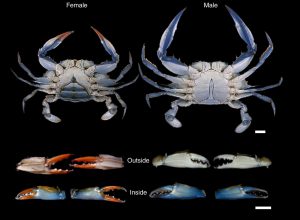
Though there are some marine insects and arachnids, most saltwater arthropods are in the subgroup Crustacea – possessing 10 legs and two sets of antenna. The crustaceans can be subdivided into the following groups: Copepods, Isopods, Amphipods, Decapods, and Cirripeds. The actual division of crustaceans, and arthropods in general, is much more complicated and too much for a lesson like this. It is also constantly changing. So, we will go with these more common ones.
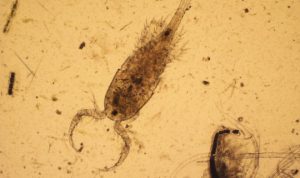
Photo: Texas Tech University
Copepods
Are tiny planktonic crustaceans that resemble cock roaches under the microscope. The ocean is FULL of them and many marine biologists consider them the most important animal in the ocean. This is because they connect the microscopic plant world, and its photosynthetic energy, to the larger marine animal world via the food chain. Remember, there are no grasses or shrubs to feed the system in the ocean. The phytoplankton are the “grasses of the sea”. Copepods drift in the ocean consuming diatoms and dinoflagellates and then, in turn, are fed on by plankton feeding creatures such as herring, corals, sponges, jellyfish, and even whales. These animals, in turn, provide food for the ocean’s carnivores. Many copepods have a single eyespot to detect day and night and migrate down during daylight hours. A few copepods are parasitic and found on the gills of fish.
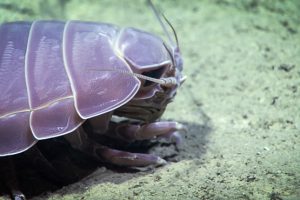
Photo: NOAA
Isopods
The famous “roly-poly” in our yards belong to this group. We would think, having them in our yard, they are not crustaceans – but they are. There are over 4000 species of isopods, making them one of the large subgroups of crustaceans. These look like tanks. A shell covered body with many segments. Some in the deep sea can get over a foot long and are truly creepy.
The creature many call the “rock roach” is not a roach at all, but an isopod. Roaches are insects. The “rick roach” can be seen running along docks, seawalls, and rocks along the shoreline. It is known as Ligia.
Some species of isopods are parasitic and can be found extending between fish scales or on their gills.

Photo: University of Florida
Amphipods
These are the true “sand fleas”. The creature fishermen call sand fleas are actually crabs and mentioned further down. Amphipods are tiny shrimp looking creatures that hop around the beach debris and are often called “beach hoppers”. They do bite – hence “sand flea”. Though many live along the shoreline there are many others who live within the water column of the open sea and are part of the plankton.
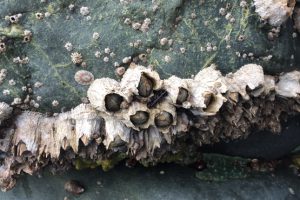
Photo: NOAA
Cirripedia
The cirripeds are the bizarre members of this group. They are commonly known as barnacles. Usually during a lab test students will place barnacles in the Phylum Mollusca, because of their calcium carbonate shells. But if you open the shell and look at the animal, it is a segmented creature with 10 jointed legs – it is a crustacean. As with many crustaceans, at birth it is a planktonic larva called a nauplius. This larva stage goes through many molts and body changes but during one stage it will settle on a solid structure. This could be a piling, dock, rocks, seawall, oysters, crab shell, turtle shells, you name it. The animal now secretes a cement and becomes sessile (non-motile). It sticks by its back and extends its legs into the water column to feed on plankton. The body and legs will now be protected by building a calcium carbonate shell around them. There are a series of plates that form doors and a wall surrounding the barnacle. The doors can open, the barnacle extend their jointed legs to feed, and close when the tide or predators arrive. Barnacles can be problematic for creatures who obtain them growing on their bodies so much effort is used to remove them.
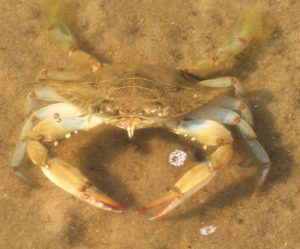
Photo: Molly O’Connor
Decapods
The decapods are the most famous of this group. These are the crabs, shrimps, and lobsters. It also includes their freshwater cousin the crawfish. All of these are famous for being a favorite seafood item. Billions of dollars are made each year in the seafood industry fishing for crabs, shrimp, or lobsters. Many attempts have been made to farm these animals.
Decapods have a fused head and thorax forming the cephalothorax – the shrimp head. The cephalothorax is covered by a single piece of chiton called the carapace where the “walking legs” – the 10 legs – of the crustacean can be found. Many species have modified one set of these into chelipeds (claws) which they use to grab and cut food. They do not have teeth, but rather have moving plates as mouth parts, much of the cutting and “chewing” is done with the chelipeds. Though some decapods can feed on fish, most choose dead carcasses because of ease. Shrimp are basically bottom feeders and do so more at night.
Decapods are found in most marine habitats – including the deep sea. Some dig burrows and others live in rock cervices. Many will “click” their chelipeds and making a “snapping” sound you can hear while snorkeling. It sounds like bacon frying in the pan. The largest of the group are the Alaskan King Crab which can reach a leg span of 11 feet and their legs are a popular seafood dish.
Some crustaceans have made the trip to land. Ghost crabs are common on beaches and dig burrows down to the water level where they can keep their gills wet. They usually emerge at night to feed on carcasses and debris on the beach. Fiddler crabs are their cousins who prefer the marshes. The male can be identified by the one large cheliped which he waves in the air to attract females and warn revival males. They too, will dig burrows which they seal them off with mud when the tide comes in. They are often found with round balls of sand near the entrance. These are called pseudo feces and are the remains of cleaned sand searching for food particles by the crab.
One of the more peculiar crabs in the group is the hermit crab. This animal does not have an exoskeleton covering its abdomen. So, it must find a mollusk shell to cover it. Studies have found they really do not have a preference as to what type of shell, as long as they have a shell. They will fight with other hermit crabs to find a shell even pulling individuals from their shell to do so. As you would guess, the mollusk shell does not grow so the hermit must find new shells as it gets bigger.
“Sand Fleas” are not actually fleas but a crab – called a mole crab. They use their spine like telson to dig into the sand near the surf extending their head and large antenna into the water column to grab planktonic food. The surf does wash them from their anchorage, and they must quickly dig in before predatory fish – like pompano and whiting – find them. Shorebirds are also known to hunt these guys.
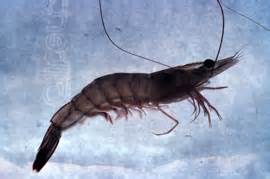
Photo: FishWatch
Our bay shrimp are one of the most prized seafood targets on the planet. Two species are common, and popular, in the Pensacola Bay area. The Brown Shrimp – also known as the “bay shrimp” or “brownies” – is most common in the bay. They are smaller. The White Shrimp – also known as the “Gulf shrimp” is a little bigger. These can be found in the bay but are often harvested in the Gulf. Both species of shrimp migrate offshore into the Gulf for breeding. The planktonic larva drift back into the estuary where they grow into adults and the process begins again. These shrimp will only live one season.
Blue crab is another popular seafood target in our area. Male crabs are more common in the upper estuaries, migrating towards the pass during breeding season. The males will ride the backs of the females for several days in what the fishermen call “doublers” and, at some point, will deposit his spermatophore under the female’s abdomen. He will then leave. Females will wait for good conditions and then fertilize their eggs. This forms a bright orange egg mass beneath the abdomen which eventually turns a darker brown when they larva are ready to hatch. Females with these spongy egg masses are called gravid females and are illegal to harvest in Florida. The young emerge from the mass as plankton forming what are called zoea larvae. These will molt into megalops before rolling their abdomens beneath their cephalothorax and become juvenile crabs. The live span of blue crabs is about five years.
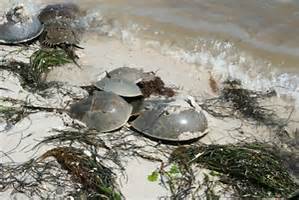
Photo: Florida Sea Grant
Horseshoe Crabs
Horseshoe crabs are not actually crabs at all – as a matter of fact – they are not crustaceans. Though they may resemble crabs, maybe resembling armored stingrays more, and they do have 10 legs, they lack antenna and are more closely related to the arachnids – spiders, scorpions, and ticks. This is an ancient animal with fossils of the same form we see today in rocks dating 400 million years. Today there are four species still roaming the earth. One, Limulus polyphemus, is found along the Atlantic and Gulf coasts of the United States. These armored tanks plow their way through the substrate pushing up food in the form of worms and other invertebrates. They are most often found in high saline estuaries where seagrass is abundant but have also been found in muddy bottoms and out in the open ocean.
They have a cephalothorax covered in a thick chitinous shell. The abdomen is flat and spined with large “book gills” beneath. There is also a long spine called a telson extending from the abdomen. This spine is on a ball and socket joint and can be rotated in a circle. It is most often used to right the animal if it becomes upside down while feeding, or when it is in the surf during breeding. It is harmless to humans. As a matter of fact, their chelipeds are harmless as well. This is a cool, but creepy animal to pick up – but I would encourage you to do so. They are VERY cool! But remember… they are marine animals and need to be placed back in the water ASAP.
Reproduction in this animal is really cool. In the spring and fall, they will approach the beaches within an estuary near the mouth of the bay. The large females crawl along the bottom heading towards shore while the smaller male grabs on to her. They do so by using a modified claw that resembles a hooked club. Usually there is only one male on her back, but others will follow close by and are called satellites. During the spring high tides (full and new moons) she will approach the beach to dig a burrows near the surf. She will deposit her eggs and the males scramble to fertilize them first. Interestingly, studies show that successful fertilization usually occurs with one of the satellite males, not the one riding on the back. The fertilized eggs will incubate in the warm sand until the next spring high tide comes and releases them – as little baby horseshoe crabs.
These ancient animals, who lived through the loss of the dinosaurs and more, are on the decline now. Their blood contains hemocyanin instead of hemoglobin. Hemoglobin contains iron, and important part of our diet, and – when in contact with oxygen – will appear red. Hemocyanin is copper based and – when in contact with oxygen – the blood will appear blue. But there is a particular amebocyte enzyme associated with this blood that is of interest to humans. Called Limulus Amebocyte Lysate (LAL) it can detect the presence of bacteria by forming blood clots when it does. This LAL is used in hospitals across the planet to assure that medical equipment and supplies are decontaminated and clean before medical procedures. Anyone who has had a medical procedure can thank this animal for a sterile situation for that procedure. However, the animals must be bled to obtain the LAL. Horseshoe crabs are collected for this, and returned after being bled, but many do not survive. Scientists are currently working on a synthetic version of this compound so the crabs will no longer have to be harvested.
But… they are also collected as bait for the eel fishery along the Atlantic coast. The animals are being monitored in Florida and there is a citizen science project searching for them locally. Contact Rick O’Connor (roc1@ufl.edu) if you are interested in volunteering.
The Crustaceans – like the insects – are a HUGE group and we could go on and on and on about them. They are a semester marine biology course in themselves. BUT we have scratched the surface, so you better understand them. Let’s try some activities.
ACTIVITY
- If you have a magnifying glass, or microscope, look at a photo from the newspaper, magazine, or book. Up close you should see colored dots. Farther away, the image in the photo. The more lens in the compound, the more it looks like the full image.
- If you can, take a walk along the beach and see how many different kinds of crustaceans you can find. You may only find their shells. Check the wrack and debris for hidden treasures.
- If you can, visit a seafood market and see all of the different kinds of crustaceans that have for sale. In the large markets, the numbers are amazing.
- Search the internet for a video of a molting crab or shrimp. I think you will be amazed.
- Do a “roly-poly” hunt in your yard. You will probably find other kinds of arthropods while searching. Wear gloves while turning over rocks, logs, and flowerpots. Spiders lurk here as well.
- If you have a Lego set, see if you can connect pieces to form an arm that can reach your mouth while bending it. This is how arthropod limbs work.
 0
0
